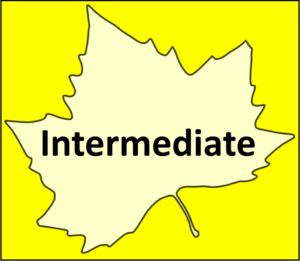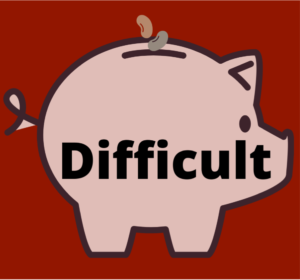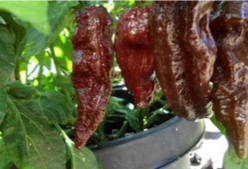
Peppers
Peppers are grown around the world. They can range from sweet to spicy hot! The capsaicin found in peppers is what makes them hot. Even sweet peppers can become spicy if summer temperatures are extreme and spicy peppers will become even hotter.
|
Banana; Long Blend |
|
California Wonder; Carnival Blend; Chinese Giant |
|
Heatless Habanada |
|
Tam Jalapeno; Tobago Seasoning |
|
Datil; Fish; Goronong; Greek Pepperoncini; Hot salsa blend; Hungarian Wax (banana);Jalapeno Early; Jalapeno Gigante; Jalepeno M; Long Slim Red Cayenne |
|
Ghost Pepper (Bhut Jolkia) |
|
Caspsicum annuum Datil; Ghost Pepper: Caspsicum chinense |
|
Intermediate |
|
Difficult |
|
2-3 years if properly stored |
|
Annual |
|
14-21 days |
|
None |
|
1/4 inch |
|
Full sun |
|
Banana: 72 days Bell varieties: 60-90 days. usually 4 x 4” to 4 x 6” fruit Jalapeno: 3” Jalapeno M: 4.5” Tobago Seasoning: Fruit 2-3” |
|
February and March |
|
Yes |

Growing Tips


When to Start
Spring: Start indoors 8-10 weeks before the last average frost date. (End of February beginning of March for GA.)
Transplant: After the danger of frost has passed. (May 1 for GA)
How to Start
Peppers need a good bit of time to grow before they are ready for transplant. Start indoors 8-10 weeks before the last average frost date. Sow 3 seeds per cell to a depth of 1/4 inch. They like soil temperatures to be between 65-75 degrees. You can place them on the top of the fridge (as peppers don’t need the light to germinate) or purchase a seedling heat mat. Just make sure you get a water-resistant one and read the instructions carefully.
You can get peppers to germinate without a heat mat, just be aware germination may take longer. Once they germinate place them under grow lights. Give them 12-16 hours of light per day. After at least 2 true leaves appear, thin to the strongest seedling. True leaves look like the leaves of the mature plant.
Care
Transplant into a full sun bed with well-draining soil. Space plants 18-24” apart. Cages can be helpful to keep the plants supported and branches from breaking.
As a member of the nightshade family, peppers have similar care requirements and problems as tomatoes. Blossom end rot is one such problem. Follow the guidelines in “12 Tomato Planting Hacks” for how to keep your peppers from suffering this malady and other helpful tips. The link is below.
Give consistent water. Bottom water, slowly and evenly, and keep the soil moist but not soggy. This will also help develop a good root system. If the soil is dry 1-2 inches down it’s time to water. Mulch is also helpful, not only for suppressing weeds but retaining soil moisture.
Harvest
Peppers can be harvested any time the fruit is a good size. Green peppers are unripe fruit, while ripe fruit can be red (most common) chocolate, purple, yellow, or orange. It can take quite a while for peppers to ripen. Tip: For a more continuous supply of peppers, let only 1 or 2 peppers ripen on the plant and harvest the green ones. Otherwise, the plant will put all of its energy into ripening peppers (seed production) and not producing more peppers.
Pro Tip!
Incompatibles: Fennel and kohlrabi
Grows well with: Basil, carrot, eggplants, onions, parsley, and tomatoes
My personal experience
I start peppers every year from seed. My heat mat is in use by other plants, so I’ve never used one to aid germination with peppers. They seem to germinate just fine without it. However, my grow lights do put out a fair amount of heat.
Most years my peppers do very well. I like to plant sweet alyssum in with my peppers. It is a good living mulch and it attracts numerous beneficial predators. I also like to put a handful of crushed eggshells at the roots when planting. See my 12 tomato planting hacks for why.
When sweet becomes spicy
I prefer sweet peppers. Only one year did my sweet peppers turn spicy. Hot temperatures affect the level of spiciness peppers develop. The year my sweet peppers turned hot was the year we were in record temps for an extended period of time. Fortunately for me, the peppers weren’t too spicy for what I enjoy!

Seed Saving

Isolation Distance
Though peppers are self-pollinating, cross-pollination may occur. Insects, such as bees, or wind may deliver pollen from a sweet pepper plant to a hot pepper plant, and vice versa.
The flavor and appearance of the pepper fruits are not immediately affected when this happens. The peppers develop normally and taste as they should, but seeds collected from these cross-pollinated vegetables will not produce plants and fruits of the same variety and spiciness. You may find a sweet pepper has spicy notes or the color of the pepper is different than expected.

Instructions
To avoid cross-pollination, you can either cage the whole pepper plant or a single flower. To cage the whole plant, you can use a nylon screen (you want something that says insect barrier). To cage, a single flower, use the same material and tie (not too tightly) around the bud, before it opens up. Mark the stem with a color string.
Once the fruit is starting to develop, remove the bag, but leave the colored string so you know which pepper will be true-to-type. Allow the chosen fruit to remain on the plant until it becomes completely ripe and begins to wrinkle. You must ensure that the pods you have chosen become fully mature for maximum pepper seed viability; this may take several months. Then remove the seeds from the peppers.
Inspect the seeds and remove any that are damaged or discolored, then spread them out on paper towels to dry. Place the drying seeds in a warm area out of direct sunlight. Turn the seeds every couple of days to make sure the bottom layer is drying as well. After a week or so, check to see if the seeds are dry enough. Dry seeds will be quite brittle and will not indent when you press your fingernail into them.

Features
- Banana: Heirloom. A light green pepper that turns yellow, orange, and finally ripens to red. It is good for frying or fresh.
- Long Blend: A mix of Corno di Toro and Sweet Banana.
- California Wonder (Bell): Heirloom. Thick-walled, tender, and flavorful. Good for stuffing.
- Carnival Blend (Bell): A mix of gold, orange, purple, ivory, and red. A mix of California Wonder, Diamond, Golden California Wonder, Orange Sun, and Purple Beauty.
- Chinese Giant: Has medium-thick, sweet flesh. Fruit is 4-6 inches, ripening to red.
- Heatless Habanada: All the flavor of a habanero without the heat.
- Tam Jalapeno: A very tasty, mild jalapeño type. Heirloom.
- Tobago Seasoning: A traditional ingredient in jerk seasoning in the Caribbean. Two to three-inch scarlet peppers are milder than a traditional habanero. Heirloom.
- Datil: Heirloom. Fruity and spicy in flavor, they are good for jellies, salsas, and sauces. The heat is described as ‘vicious‘, comparable to habaneros but with a more complex flavor.
- Fish: Heirloom. A historic African-American heirloom is known for its striking green and white leaves and colorful peppers that shift from creamy white to deep red.
- Goronong: Heirloom. A truly rare habanero-type pepper from Malaysia with beautiful contorted pods in a canary yellow color. The heat is approximately equal to a habanero; the pods reach about 3.5 inches long and are quite ornamental.
- Greek Pepperoncini: Great for pickling, salads, salsas, and fresh. Harvest the peppers when they are light yellow and 2-3″ long.
- Hot Salsa Blend: Includes Hungarian Wax, Anaheim Chili, Long Slim Red Cayenne, Ancho (Poblano), and Jalapeno.
- Hungarian Wax: It is a great pepper for stuffing, roasting, and topping pizza.
- Jalapeno Early: Three-inch dark green peppers. Good fresh or pickled.
- Jalapeno Gigante: The largest jalapeno stuffing pepper.
- Jalapeno M: Vigorous plants that produce 4.5-inch fruit.
- Long Slim Red Cayenne: Very hot peppers. They are vigorous and very productive. Good for drying and grinding into a spice.
- Ghost Pepper (Bhut Jolokia): 8th hottest in the world as of Nov 2025. Conical pods grow 2-3 inches and have wrinkled skin that ripens to red. Fruits and seeds should be handled with protection. For proper germination, Trade Winds Fruit states the soil temperature must be kept at 75-90°F. And that cool soil temperatures, especially at night, can inhibit or significantly delay germination. Allow 2-6 weeks for germination.

Place a handful of ground eggshells in the bottom of the hole before transplanting. This will help prevent blossom end rot as the egg shells break down releasing calcium for the plants to absorb.
Use a cage to help support the plants.
For a more continuous supply of peppers, let only 1 or 2 peppers ripen on the plant and harvest the green ones. Otherwise, the plant will put all of its energy into ripening peppers (seed production) and not producing more peppers.
